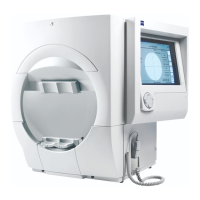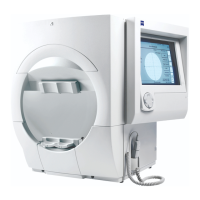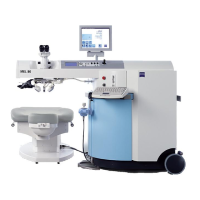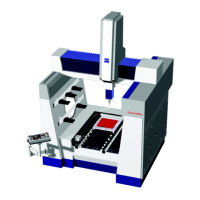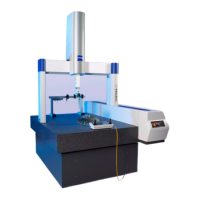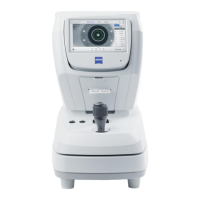HFA3 Instructions for Use 2660021166131 Rev. A 2018-11
Go to Contents Data, Tests & Reports
6-13
compared to the reference limits. These are explained in the legend labeled “Probability Symbols.”
For instance, a totally black square indicates that the value observed at that point location occurred
in less than 0.5% of the subjects in the reference database.
Pattern Deviation Plots
The Pattern Deviation plots are similar to the total deviation plots, except that STATPAC has adjusted
the analysis of the test results for any changes in the height of the measured hill of vision caused, for
example, by cataracts or small pupils. STATPAC also corrects for any patients who are “supernormal.”
Global Indices
Visual Field Index (VFI): VFI is a weighted aver
age of the ratio of the measured threshold to the
age-adjusted normal threshold for all points that have depressions in the Pattern Deviation at the
5% level or higher. The VFI is weighted to give increased importance to thresholds near the point of
fixation.
Mean Deviation (MD): MD is the ave
rage elevation or depression of the patient’s overall field
compared to the normal reference field. “P” values are given to significant deviations.
Pattern Standard Deviation (PSD): PSD is
a measurement of the degree to which the shape of the
patient’s measured field departs from the normal, age-corrected reference field. “P” values are given
to significant deviations.
Short term fluctuation (SF): SF is used with Full Thr
eshold and FastPac
™
tests. When fluctuation is
turned on, the threshold is measured twice at 10 preselected points. The HFA then calculates a
fluctuation value on the basis of the differences between the first and second measurements at each
of the 10 points.
Corrected Pattern Standar
d Deviation (CPSD): CPSD is PSD corrected for intra-test variability (SF) and
is used with Full Threshold and FastPac tests only.
The Glaucoma Hemifield Test
For 24-2 and 30-2 tests, the GHT evaluates five zones in the superior field and compares these
zones to their mirr
ored zones in the inferior field. One of these messages will be displayed: WITHIN
NORMAL LIMITS, OUTSIDE NORMAL LIMITS, or BORDERLINE. The message GENERAL REDUCTION
OF SENSITIVITY is shown whenever the field is depressed to a level seen in fewer than 0.5% of the
normal population in the patient’s age range. When the comparison indicates abnormally high
sensitivity, the message ABNORMALLY HIGH SENSITIVITY appears.
Note: The GHT is not available with FastPac tests.
Numerical and Graphical GPA Plots
Deviation from Baseline Plot
The Deviation from Baseline Plot compares the pattern deviation of a Follow-up test to the average
of the pattern deviation values of two Baseline tests, and indicates changes at each tested point.
See Figure 6.3.
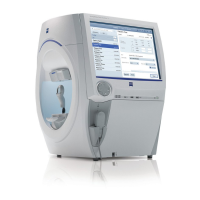
